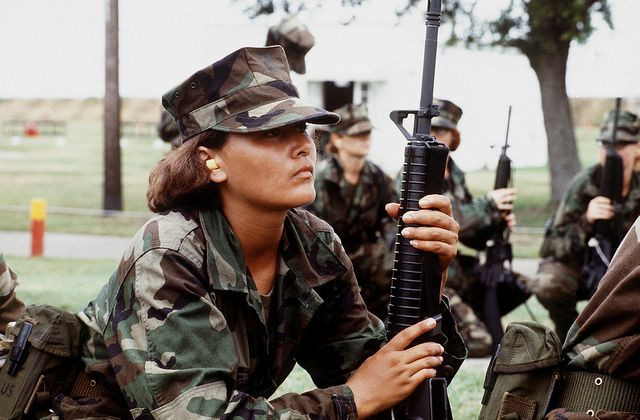Women, Rookie Soldiers From The Iraq And Afghanistan Wars Face Higher Risk Of Attempted Suicide

During the wars in Afghanistan and Iraq, suicide and attempted suicide among soldiers in the United States Army increased dramatically in comparison to other branches of service. A new analysis of the data from that period spells out the risk factors for suicide among enlisted soldiers.
Generally, the soldiers most likely to attempt suicide included women, those who had entered the Army at age 25 or older, those who had not finished high school, and those currently 29 or younger, the study results indicate.
Specifically, women soldiers, who made up about 14 percent of active duty solders during the two wars, were more than twice as likely as their male counterparts to attempt suicide.
"The risk for completed suicide (in a previous study) is highest for men and highest among those who are deployed. What was not previously known were the actual rates and numbers of suicide attempts," Dr. Robert J. Ursano, a professor at the Uniformed Services University Medical School, told Medical Daily in an email.
“Enlisted soldiers constituted approximately 84 percent of the Army and nearly 99 percent of suicide attempters,” Ursano and his co-authors noted in their published study. “Among those who attempted suicide, 5,774 enlisted soldiers (59.8 percent) and 99 officers (70.2 percent) had a previous mental health diagnosis.”
Creating a Profile
Ursano and his colleagues examined data from 9,791 Army personnel who attempted suicide during the wars in Afghanistan and Iraq — between Jan. 1, 2004 through Dec. 31, 2009. The Army Study to Assess Risk and Resilience in Servicemembers, which incorporates all documented suicide attempts among active-duty Army members, provided all the necessary information. The researchers perused the records of both enlisted soldiers and officers. Enlisted soldiers, the official website of the Army indicates, carry out orders and complete missions, often performing jobs specific to an occupational specialty. Officers, both commissioned and warrant officers, hold positions of authority.
Analysis immediately revealed an uneven distribution of suicide attempts. Enlisted soldiers, who constituted 83.5 percent of active-duty regular Army soldiers, accounted for 98.6 percent of all suicide attempts: a total of 9,650 attempters, the researchers discovered. While constituting 16.5 percent of the Army, officers accounted for the remaining 1.4 percent of all cases.
Among enlisted soldiers, those with higher odds of a suicide attempt were female, had entered service at age 25 or older, were currently 29 or younger, and had not completed high school, analysis indicated. Meanwhile, officers with increased odds for attempting self-destruction were female and had entered Army service at age 25 or older. Enlisted women had nearly 13 times the risk of female officers for a suicide attempt, the researchers estimated, while enlisted soldiers who began service at 25 or older had more than 16 times the risk of officers in the same age group.
As might be expected, risk was particularly high among soldiers with a recent mental health diagnosis. Among enlisted soldiers, risk was highest during the second month of service and declined substantially as service time increased. Among officers, risk remained stable over time.
Higher odds of suicide attempts were found among never deployed and previously deployed enlisted soldiers; currently deployed soldiers had lower odds overall. As for the sunlight in this study, enlisted soldiers with the lowest odds for attempting suicide, the researchers found, had entered Army service before age 21, currently were 35 or older, completed at least some college, and were black, Hispanic, or Asian. Though comprehensive, the scope of the study is limited by available data.
"We examined suicide attempts identified in medical records. There are many suicide attempts (and other self injury) that never comes to medical attention," Ursano explained to Medical Daily. However, "most likely the study identified the more serious suicide attempts," he said.
In conclusion, Ursano and his co-authors stated, “the consistency of sex as a predictor suggests that examination of risk in men and women separately may be beneficial." Going forward, they suggest incorporating factors such as sex, rank, age, length of service, deployment status, and mental health diagnosis into targeted prevention programs in order to reduce the number of both suicides and suicide attempts.
Source: Ursano RJ, Kessler RC, Stein MB, et al. Suicide Attempts in the US Army During the Wars in Afghanistan and Iraq, 2004 to 2009. JAMA Psychiatry. 2015.



























